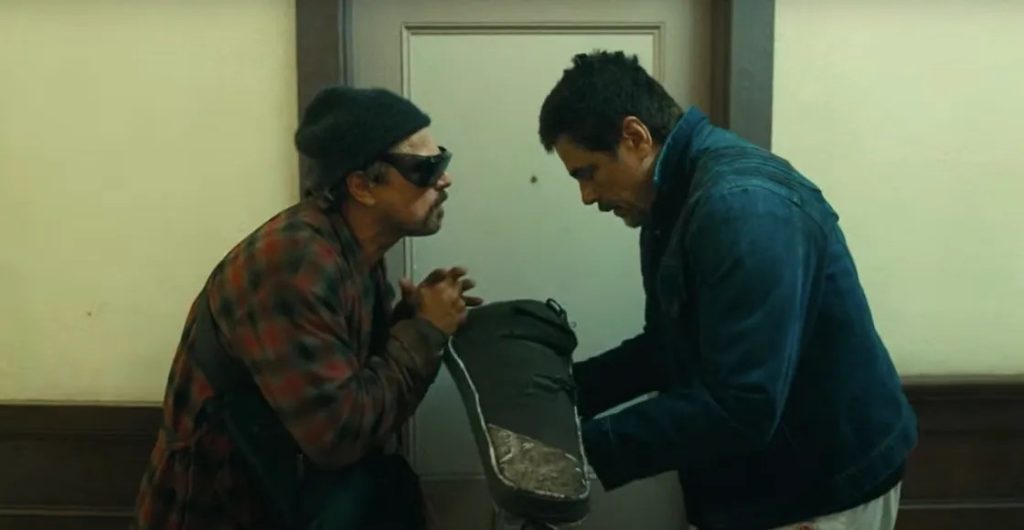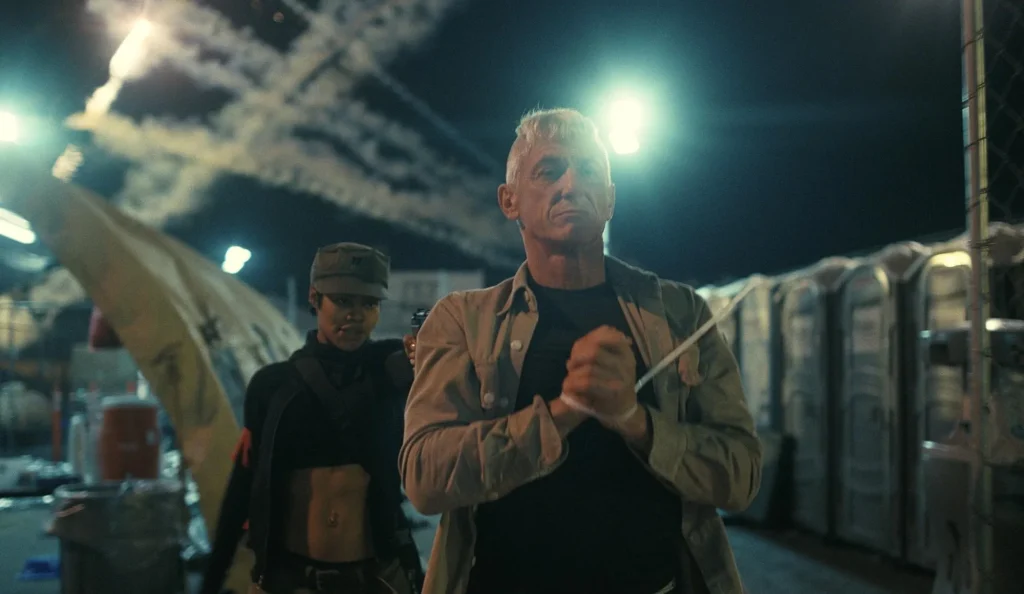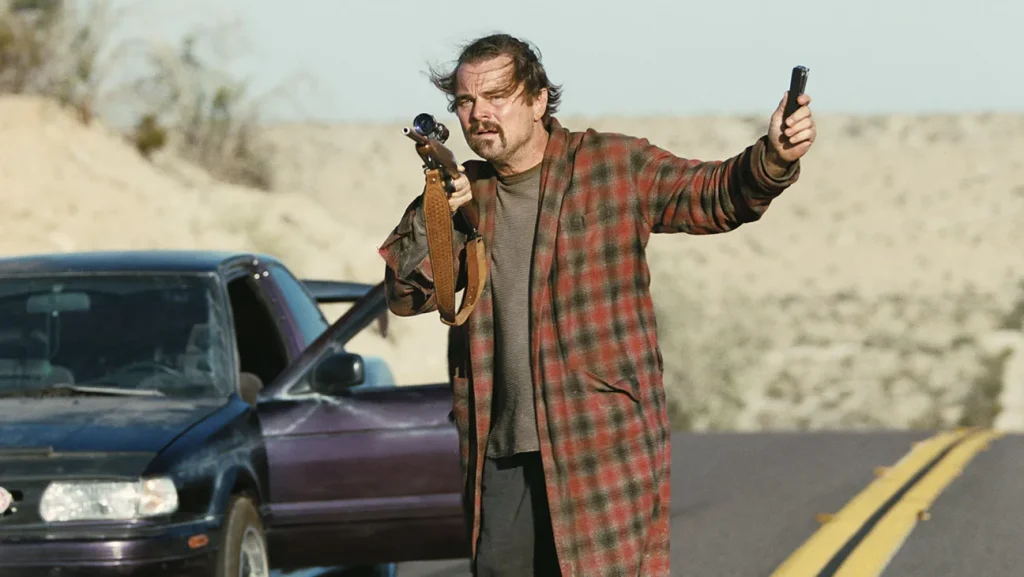
Paul Thomas Anderson is one of the few contemporary filmmakers whose voice carries across very different films: the ensemble chaos of Boogie Nights and Magnolia, the domestic tension of Phantom Thread, the paranoid tenderness of The Master. His work borrows structural daring from Altman and moral intensity from Scorsese, yet it always feels unmistakably his own—controlled chaos, human oddities, and a camera that never stops probing. In One Battle After Another, Anderson moves into larger-scale filmmaking while keeping those trademark obsessions alive.
The film follows Bob Ferguson (Leonardo DiCaprio), once a fiery revolutionary, now a widowed father living in guarded semi-retirement with his teenage daughter Willa (Chase Infiniti). Their uneasy calm shatters when news arrives that Ferguson’s old nemesis — the brutal, politically ambitious Col. Steven J. Lockjaw (Sean Penn) — has resurfaced, backed by a new regime that wants to use him as a figurehead for suppression.
Ferguson’s struggle to protect Willa while staying ahead of Lockjaw’s reach pushes them across a shifting political landscape: each stop is an episode, each episode a confrontation. The father-daughter bond becomes the emotional anchor in a story built as a chain of incidents rather than one traditional arc — hence the film’s title. Its political edge lies less in speeches and more in showing how systems of power keep reviving their monsters and grinding down those who resist.
The camerawork feels alive. The follow-cam is flexible — at times swaying like a handheld witness, at others gliding with measured control — punctuated by sudden sharp movements that make the audience literally chase the action. This restless framing creates a sense of constant pursuit: events tumble into one another with no pause. Editing is the engine here, converting motion into narrative drive, setting the rhythm so the film plays like an escalating series of encounters rather than a neat dramatic arc. The movie’s structural thrill is in its relentlessness.

Visually, the texture and color grading create an immediate, lived-in world. Everything looks tactile, weathered, inhabited. Costumes, props, and small details are paired with their surroundings in a way that subtly guides attention without calling it out. It’s a quiet but smart technique: you only realize you’ve been steered after the moment hits.
Sound design is one of the film’s boldest choices. Bullets, crashes, and sonic jolts are cut to visuals to deliver the same physical shock as a jump scare — but in a film that isn’t horror. These audio shocks are precisely placed: just as you start to settle, sound pulls you into a new clash. The effect is disorienting in the best way, keeping attention sharp. The late car chase is the peak of this approach, where editing, camera, and sound architecture combine into a sequence designed for maximum impact.
Anderson’s use of music is striking: it matches external situations more than characters’ inner feelings. Songs and score build toward crescendos only to cut off abruptly, or weave into ambient sound before dropping into silence. This alternation — crescendo then cut, song then silence — creates surprise and tonal complexity. It emphasizes the film as a series of staged incidents rather than a straightforward emotional excavation.
The film is also unexpectedly funny — humor that intensifies instead of undercuts. It’s dry, witty, often sarcastic, and delivered by actors better known for seriousness. Anderson deliberately flips their public image. These comic beats are carefully placed so they never dilute the tension; instead, they sharpen it by contrast. Comedy here is structural seasoning, not distraction.

Leonardo DiCaprio, surprisingly, becomes a frequent source of levity. He mixes physical comedy, timing, and flashes of genuine emotion that linger, balancing humor with moments of lived drama. His portrayal of Bob Ferguson is layered, marking one of his finest performances in recent years.
Sean Penn, however, dominates the film. His character defines the danger and stakes, and his performance is dark, menacing, and magnetic. It’s the kind of work that naturally attracts awards talk — a towering presence at the film’s core.
Benicio Del Toro adds a sharp, efficient, and at times dryly funny presence. He may not get much screen time, but his role functions as a tonal anchor. His brevity feels intentional, though it may leave audiences wishing for more.
Across the cast, Anderson pushes actors into spaces they don’t usually occupy: severity and silliness exist side by side because the direction demands both.
The relentless pace might be criticized for leaving less room for emotional depth. But the film isn’t built as a domestic drama — it’s designed as a cinematic experience of incidents. Anderson trades prolonged introspection for a chain of confrontations. That’s not a flaw but a choice. If you expect traditional emotional excavation, you may be left wanting; but if you embrace its terms — to be shaken, amused, and challenged — it delivers powerfully.
One Battle After Another is Anderson’s widescreen experiment: keeping his moral obsessions intact while expanding his cinematic toolkit. It’s loud when others would go quiet, funny where others would turn solemn, and technically bold where most would play safe. The film rewards patience, attention, and a willingness to let collisions — visual, audio, narrative — create meaning.
One Battle After Another is a crafted, thrilling experience that manages to be both an award-worthy film and a crowd-pleasing box office hit.
Rating: (9/10) ★★★★★★★★★☆
